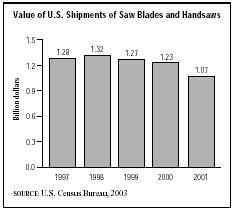SIC 3425
SAW BLADES AND HANDSAWS
This category covers establishments primarily engaged in manufacturing handsaws and saw blades for hand-and power-driven saws. Establishments primarily engaged in manufacturing power driven sawing machines are classified in the major group for industrial and commercial machinery and computer equipment.
NAICS Code(s)
332213 (Saw Blade and Handsaw Manufacturing)
According to the U.S. Census Bureau, roughly 175 establishments operate in this category. Industry-wide employment in 2000 totaled 9,724 workers receiving a payroll of almost $344 million; 6,703 of these employees worked in production, putting in almost 14 million hours to earn wages of more than $196 million. Overall shipments for the industry were valued at almost $1.1 billion in 2001.
Blount International Inc. of Montgomery, Alabama, the industry leader with 1998 sales of almost $832 million and 5,300 employees, merged with Lehman Brothers Merchant Banking Partners II L.P. in an April 1999 consolidation worth $1.35 billion. By 2003, however, Blount had moved its headquarters to Portland, Oregon. Sales that year totaled $559 million, and Blount employed 3,300 workers. Vermont American Corp. of Louisville, Kentucky held second place in the industry with sales of over $400 million. In 1998, Vermont American implemented training and teamwork programs for its nonunionized manufacturing workers and its unionized distribution center workers, resulting in improved customer service, improved turnover of inventory, and profits surpassing corporate projections. In 2000, Robert Bosch GmbH raised its stake in Vermont American from 50 percent to 100 percent, making it a wholly owned subsidiary. Other industry leaders included Black & Decker Corp.'s Power Tools and Accessories division of Towson, Maryland; L.S. Starrett Co. of Athol, Massachusetts, with 2003 sales of $175 million; and W.C.I. Out-door Products Inc. of Nashville, Arkansas.
Shipments for the saw blades and handsaws industry fell steadily throughout the late 1990s and early 2000s, declining from $1.32 billion in 1998 to $1.07 billion in 2001. During the same period, employment had risen from 9,127 workers to 9,724, a 6.1 percent increase, and payrolls advanced from $300 million to $343.4 million, an increase of more than 12 percent.
Traditionally, production in the saw blades and handsaws industry was centered in the New England area of the United States, paralleling the development of SIC 3421: Cutlery. The shift towards mass-production techniques and away from a reliance on skilled craftsman resulted in the establishment of the industry in heartland states. The industry tended to follow the source of cheap materials and markets, differentiating it from cutlery by its marked westward migration.
The challenge to the industry early in the twenty-first century was to maintain a high level of precision for the cutting edges and to produce new metals and composites to cut the increasingly diverse range of hard-to-cut man-made materials. Modern blades must be able to last long periods of time, operating in unmanned, automatic feed industrial applications.

Sales in the saw industry were tied closely to the health of such industries as steel, housing, and lumbering, which used large quantities of saw blades and handsaws. However, the strength of the housing market in the early 2000s was not enough to offset major declines in the steel and lumber industries, which struggled with increased imports, among other things. At the same time, the saw industry itself faced increased competition from inexpensive imports throughout the late 1990s and early 2000s.
Further Reading
Infotrac Company Profiles. 1 January 2000. Available from http://web4.infotrac.galegroup.com .
U.S. Census Bureau. 1997 Economic Census—Manufacturing , 10 February 2000. Available from http://www.census.gov/prod/ec97/97m3322c.pdf .
U.S. Census Bureau. "Statistics for Industry Groups and Industries: 2000." February 2002. Available from http://www.census.gov/prod/2002pubs/m00as-1.pdf .
——. "Value of Shipments for Product Classes: 2001 and Earlier Years." December 2002. Available from http://www.census.gov/prod/2003pubs/m01as-2.pdf .
Comment about this article, ask questions, or add new information about this topic: